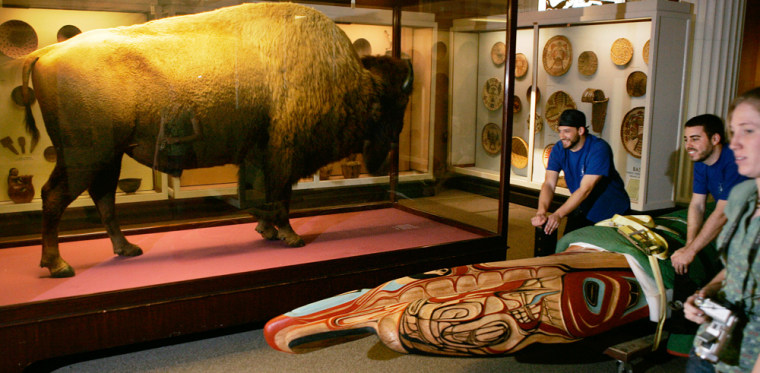A new 15-foot totem pole that marries traditional carving styles with contemporary techniques was erected Monday at The Field Museum, replacing a pole that was returned to an Alaskan tribe.
The new totem pole was carved by a father-and-son team from a western red cedar tree given as a gift to the museum from the Tlingit community of Cape Fox, Alaska.
In 2001, the museum returned one of its most treasured items - a 26-foot totem pole removed from southeast Alaska in 1899 by a scientific expedition - to the Tlingit people.
The new pole was carved by Nathan Jackson, a master carver and member of the Chilkoot-Tlingit Tribe of Alaska, and his son, Stephen Jackson, a sculptor based in New York City.
Nathan Jackson's wife, Dorica Jackson, did much of the painting. She also helped her husband navigate the Internet when their son sent his proposed design and follow-up changes via e-mail.
Following months of work in the family's workshop in Ketchikan, Alaska, the three have been putting the finishing touches on the totem pole for the last two weeks, working in front of the public in the museum's massive Stanley Field Hall.
The trio had been toiling for 24 straight hours to finish the pole before it was installed Monday morning.
The result is a totem pole painted in brilliant colors of red and turquoise. Like the pole it is replacing, it features representations of a bear and birds. But in a nod to contemporary art, it also features an abstract, swooshing, molded silicone element created by Stephen Jackson.
"It was challenging, because maybe my ideas have diverged a little bit from his," said Jackson, who began carving with his father at age 14. "We were trying to figure out common ground. I think we did - we found some."
The totem pole measures about 3 feet wide, and weighs about 1,500 pounds - including the steel supports that keep it in place. The platform on which it rests is a transition point where the museum's new "Ancient Americas" exhibit meets the Field's long-standing area devoted to the native cultures of the Pacific Northwest.
The original totem pole - along with artifacts housed at four other museums - was returned to the Tlingit people in 2001 under the 1990 Native American Graves Protection and Repatriation Act.
It was removed in 1899 by what became known as the "Harriman expedition," a survey along Alaska's coast led by railroad magnate Edward H. Harriman and a group of artists and scientists.
The group thought the Cape Fox village of Gaash had been abandoned, and left with treasures that eventually found their way to some of the country's leading science museums, said Janet M. Hong, a project manager for exhibitions at the Field.
Large numbers of Tlingit members had been killed by smallpox and other diseases that accompanied white explorers and fur traders. The survivors were encouraged by missionaries to move to more consolidated areas so their children could attend Western-style schools, Hong said, but the village was still used and visited by Tlingit people.
Nathan Jackson said it was an honor to participate in a project that brings full circle the removal of a totem pole from a village of his ancestors more than 100 years ago. He also said he believed The Field Museum acted as a good custodian of that pole.
"It was brought back in good shape," he said.
